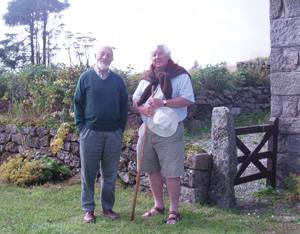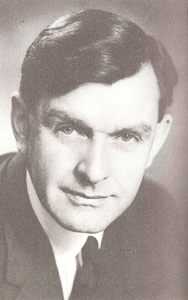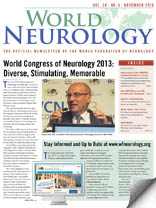
Alan Emery (left) with the author on Dartmoor in Southwest England.
By Christopher Gardner-Thorpe, MD, FRCP, FACP
I think I could turn and live with animals … Not one kneels to another, nor to his kind that lived thousands of years ago …
Walt Whitman, Song of Myself, Verse 32, 1881
This neurohistory column in World Neurology bears witness to the fact that there is increasing interest in medical history as a specialty. Many medical journals, and some textbooks, including Bailey and Love’s A Short Practice of Surgery, carry references to the history of the specialty that has always provided an intriguing glimpse of another world. Medical books and journals often discuss the history of their subjects and over recent years dedicated medical history publications have appeared and explore the subject in depth. The Journal of the History of the Neurosciences is a specialist journal edited by Peter Koehler and others and, coupled with book publications and some series of specialist history volumes, now provides a good platform for aficionados of neurohistory.
Why Medical History?
The teaching of medical history may rely upon three principal aims. The first is that it is necessary to look backward in order to understand how we have arrived where we are now and, ideally, to avoid treading the same pathway in the future where that pathway may be problematic. In other words, we learn from experience, or at least we should do so. The second is that it should be an academic discipline bringing, to the rigor of thinking, a proper academic approach to the gathering and sifting of information, and to making judgments and leading thereby to new pathways forward; a sort of dialectic where the thesis, antithesis and synthesis form a triad, each synthesis becoming a new thesis. The third is that it should be fun because things that are fun and interesting tend to capture the imagination and spur us to move forward. Perhaps this column will help achieve these aims and foster further interest in what we do and what we should do and also encourage others to join a happy band of new-age explorers.

Stanley Graveson
The basis of any specialty is the people involved. Thus biography needs to come first. There are arguments for exploring the life history of those who contribute to a topic and biographies of neuroscientists abound. Some have achieved great things in a speciality, some have achieved great things in parallel fields including writing and some have become failed eponymists, those who have discovered things but whose name has not been attached to the discovery.
In the first group are many whose names we know from the neurology of long ago (Willis, Broca, Duchenne, Charcot, Gowers, Hughlings Jackson, Head, Critchley, Brain and others) and we can write of them. Fascinating books and papers abound, and there are many lessons to be learned from these earlier days of neurology. Thus biography grips us all, and we like to learn of the lives and experiences of our forbears. In the second group, we can be fascinated by the writings of Oliver Wendell Holmes, Arthur Conan Doyle, Somerset Maugham and in our own time Oliver Sacks, among others. Some have become medical truants. Some have written poetry (Dannie Abse) and some of the writing leans toward the neurological. In the third group, we can include Edward Meryon who described the dystrophy attributed subsequently to Duchenne, now often styled Meryon’s disease.
Many neurohistorians are collectors of books. A great worry nowadays is that since so much published on the Internet will not reach permanent paper form, the availability of publications has become greater but the ability to browse has become harder and the long-term storage of important information may fail in content and in recall. The wealth of electronic publication flying through the ether, often not peer viewed and published indiscriminately, complicates matters. Dusty old books give a pretty clear indication of the thinking of our forbears. Eponyms are often much easier to recall than disorders classified by number.
Neurohistory Collections
Collections of books in a sense comprise a museum. Specific neurological museums are uncommon, but many museums are dedicated to medical history, including the Berlin Medical Historical Museum and Virchow’s collection at the Charité, and the marvellous wax-work anatomical museums at La Specola in Florence and at the Josephinium in Vienna, the work of Joseph Towne (1806-1879) at Guys Hospital, the wax embryos at the Whipple Museum of the History of Science in Cambridge, and elsewhere. Those who state that dissection of real anatomical material is no longer necessary in the medical course are justified by some extent by the beautiful wax models that provide a three- dimensional view of the brain and the nervous system. Plasticized cadaveric material and plastic models can be quite lifelike but old timers believe dissection of real tissue is still needed. Nevertheless, today’s emerging doctors seem none the worse for having grown up without classical dissection.
Today’s junk forms tomorrow’s museum exhibits, and it is important to acquire and collect. Many personal collections of ephemera, those items that otherwise are discarded as no longer of any use — papers, equipment, drugs, collectible items that are used for only a short time — will provide to those who come after us a window on the neurological world that we experienced. X-ray films have all but disappeared in favor of CD-ROMs. Old isotope scans from rectilinear scanners and gamma cameras, carotid and vertebral angiograms on film, air encephalograms and ventriculograms, are things of the past and show the progress made eventually by CT, MRI and PET. Many of the basic ideas behind these new techniques seem so simple that they should have been conceived earlier. The truth is they depended on special technology, computing power in particular, and it is interesting to muse upon forthcoming developments and to say, for example, to those who feel that the technology behind CT is obvious, “Well, what then do you think in the future will appear obvious but which we have not yet invented?”
But it is still people who matter and who shape the future. So far we are not ruled (wholly) by computers and robots so we can make decisions and determine, or so we think, our own destiny. Neurologists might question this, believing that studies of the contingent negative variation indicate that something we think we have thought up, conjured from our own minds, is original whereas perhaps we are just made aware of some primitive activity that is programmed and not initiated voluntarily. Maybe we do not have an original thought in our heads. Maybe Jung’s collective unconscious in some way controls what we do, a sort of science fiction that has become science fact.
Our Teachers
Who has had a great influence upon each of us? Influential teachers for each of us, and bosses and colleagues who have influenced us individually. Neurohistory takes so many forms. What has caused each of us to become interested in the nervous system, and why did we enter a particular subspecialty? The evolution of clinical neuroscience into physician- and surgeon-based, with the subdivisions by disease, by imaging and microscopy and so on, evokes many stories. Each is based upon the work of one or more individuals who were at the right place at the right time. Just as gliomas may originate from many foci seemingly simultaneously, so do ideas become reality depending upon the availability of new techniques, most obviously computers in the present era and based upon technology that we can not dream of in the future but which will become commonplace to the extent that future colleagues will say “Why was this not developed before?”
Just as we do in the investigation of malpractice claims, we must judge, if judge we must, on the basis of what was happening at the time of relevant prior events. In the future, others will ask whether in the 21st century we really did administer poisonous chemicals by mouth and by injection, whether we really did open up the body with a scalpel or the skull using a drilling machine, why we did even approach an organ (brain, heart, bile duct) by the natural tube (artery, vein, gut) that led to that organ in order to probe, enlarge, coagulate and coil, instead of heaven knows what alternative might become available instead.
We can write of those teachers who are no longer with us. For each of us, those teachers who are living now know who they are and what good influence they have had on our practice and for which we thank them. Stanley Graveson described himself as a jobbing neurologist, and this meant helping vast numbers of patients over a wide geographical area in the region of Wessex in the South of England. The stories told by colleagues and teachers regarding their experiences and research continue the stream of knowledge of what went before and of why we are where we have arrived today.
To arrive toward the end of a career in neuroscience with such a long and hard-working track record, with the ability to believe so many patients have been helped, is the aim of all, the best legacy topped by study and discovery, reading and writing, with continued learning and teaching each in our own neurological field.
Gardner-Thorpe is a consultant neurologist and editor of the Journal of Medical Biography.
